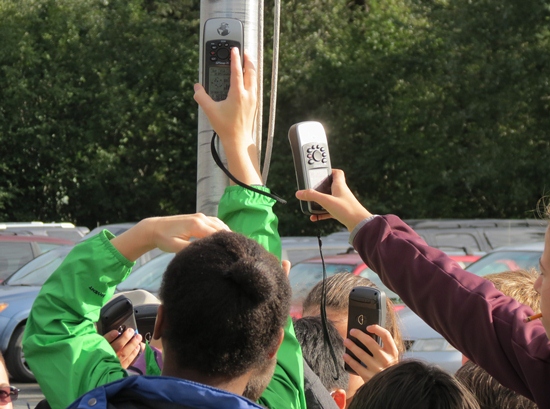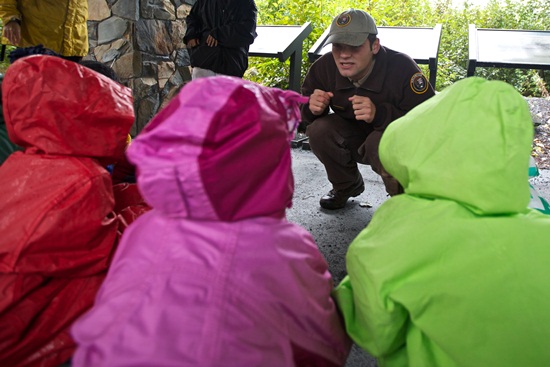A school bus pulls up outside the Exit Glacier Nature Center to unload its passengers. A stream of 6th graders pours out its door under a blanket of gray clouds. Clouds that threaten rain, but won't make good… not this day, at least. The students gather under a pavilion briefly to hear their mission and split into groups of five. Then they're off on the trails, park rangers and chaperones trailing behind as they hurry down the trails on a hunt to find different native plants using a GPS and a sheet of clues.
Last week marked the beginning of School programs out at Exit Glacier. We kicked things off with a botany scavenger hunt for the local 6th grade classes on Exit Glacier's lower trails. The beauty of a program like this one is that it is very self-directed. Sure, it took a lot of preparation at the front end (marking GPS waypoints, loading the correct points onto all the GPS units, and putting out white rocks next to all the plants we want kids to find). Not to mention teaching all the students to use a GPS at school before the lesson.

Photo: NPS / Max Odland
But after all the initial leg-work, the big day went very smoothly. Students ran the show, and better than we could have hoped.
Highlight: When the kids repeatedly figured out which way to go by looking at the GPS and didn't even ask for my help.
That experience stands in sharp contrast to our most recent excursions to the glacier.
Skies that merely threatened last week finally let loose with a vengeance, so yesterday and today we had our first kindergarten programs in the pouring rain at Exit Glacier. Kids showed up decked out in rain jackets, rain boots, and umbrellas. Still, the flooding roads and the prospect of frozen five-year-olds gave us serious pause and made us reconsider the whole program. Excitement for the field trip won out, though, and the program went on!
More drastic than the disparate weather, though, is the difference in how to teach to students at those two ages.
This program is all about introducing the kindergarten students to the park, getting them to have fun outside, and connecting them a little bit to the nature right in their own backyard. We set up four stations along the trails with different activities. My station taught the kids about mosquitoes—their life cycle and their body parts. To make a more lasting impression, I kept it high-energy and interactive.

Photo: NPS / Kaitlin Thoresen
First, all the students act out the mosquito life cycle, hunched down as eggs on the surface of a puddle. After "hatching" out of their crouches, they wriggle under the surface of the water as mosquito larvae, then pupate and emerge into the sky as adults.
After that, one student gets transformed into a mosquito with help from the audience. I dress the volunteer in various mosquito adornments (wings, proboscis, compound eyes, and antennae) while the other kids suggest what body parts a mosquito needs.
Highlight: The huge kick the kids got when they learned that my volunteer (a boy) turned into a girl mosquito (boys don't have a long proboscis).
Both programs, in the broadest sense, are about discovering where you live — whether by finding your exact geographic coordinates or by simply taking a first adventure with your class — but the two offer completely different ways to find home. Sixth graders relish a challenge, a group activity, and independence, all of which are provided by letting them take the reins and offering only laid-back guidance. Meanwhile, kindergarteners need more careful supervision, and respond to extreme enthusiasm and physical activities. Performing either of these lessons for the other age group would be a waste of time. They wouldn't make a lasting impression, because the students would have been bored or confused. Nature education is all about making connections, and that only works if you plan for the right age.
